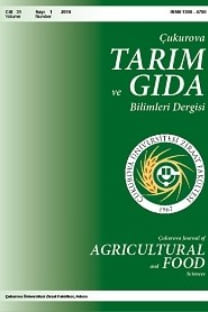Turunçgil Sarı Damar Açılması Virüs (TSDAV) Hastalığının Farklı Turunçgil Türlerinde Moleküler Olarak Tanılanması*
Turunçgil, TSDAV hastalığı, CYYCV, RT-PCR, indikatör bitki, Mandarivirus
Identification of Citrus Yellow Clearing Virus Disease Virus (CYVCV) by Molecularly on Different Citrus Species
Citrus, TSDAV disease, CYYCV, RT-PCR, indicator plant, Mandarivirus,
___
- Ahlawat, Y. S. (1997) Virus, greening bacterium and viroids associated with citrus (Citrus species) decline in India. Indian J. Agric. Sci. 67:51-57.
- Catara, A., Azzaro, A., Moghal, S. M. and Khan, D. A. (1988) Virus, viroid and prokaryotic diseases of Citrus in Pakistan. Proc. 6th. Int. Citrus Congr. 3:957-963.
- Çınar, A., Kersting, U., Önelge, N., Korkmaz, S. and Şaş, G. (1993) Citrus virus and virus-like diseases in the East Mediteranean region of Turkey. In. P. Moreno, J. V. da Graça, L. W. Timer and J. A. Doods (eds.), Proc. 12th. Conf. Intern. Organization Citrus Virol. Univ. Calif. Pres, Riverside, USA.
- Korkmaz, S. (1997) Doğu Akdeniz Bölgesi turunçgillerinde vektör ile taşınan virüs benzeri bir hastalığın yayılması, taşınması, duyarlı tür ve çeşitlerin belirlenmesi ve tanılanması üzerine araştırmalar. Ç.Ü. Fen Bilimleri Enstitüsü, Doktora Tezi, Adana
- Loconsole, G., Önelge, N., Potere, O., Giampetruzzi, A., Bozan, O., Satar, S., De Stradis, A., Savino, V., Yokomi, R. K. and Saponari, M. (2013) Identification and characterization of Citrus yellow vein clearing virus, A Putative New Member of the Genus Mandarivirus. Phytopathology, 102:1168-1175.
- Murray, M. G. and Thompson, W. F. (1980) Rapid isolation of high molecular weight plant DNA. Nucleic Acids Research, 8:19.
- Önelge, N. (2003) Türkiye’de Limonlarda Sarı Damar Açılması İle İlgili İlk Rapor. J. Turk. Phytopath. 32:1, 53–55.
- Önelge, N., Bozan, O., Gök, M. and Satar, S. (2007) Yellow vein clearing of lemons in Turkey. 17th Conf. IOCV, p. 176.
- Zhao, X. Y., Chen, H. M., Li, Z. A., Wang, X. F., Zhou, Y. K., Tang, Z. C. and Zhou, Y. (2014) First report of Citrus yellow vein clearing virus on Lemon in Yunnan, China. Plant Disease, 98:12-747.
- Zhen, S., Kurth, E. G., Peremyslov, V. V., Changyong, Z., Dolja, V. V (2015) Molecular characterization of a Citrus yellow vein clearing virus strain from China. Archives of Virology, 160(7):1811-1813.
- ISSN: 2636-7874
- Başlangıç: 1973
- Yayıncı: Çukurova Üniversitesi
Hemin İlavesinin Laktik Asit Bakterilerinde Oksidatif Stres Üzerine Etkisi
Burcu ÖZEL, Ömer ŞİMŞEK, Hüseyin ERTEN
Kırsal Yerleşmelerde Konut ve Yeni Konut İnşası
Özkan GÜĞERCİN, A. Nafi BAYTORUN
Bazı Kavun Çeşitlerine NHX-1 Geninin Transformasyonu
Tolga İZGÜ, Başar SEVİNDİK, Özhan ŞİMŞEK, Yeşim YALÇIN MENDİ
Abdulkadir BOZDOĞAN, Nüket ÖNELGE
Üzüm Çekirdeklerinin Temel Biyoaktif Bileşenleri
